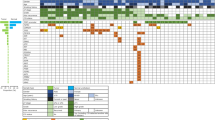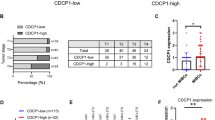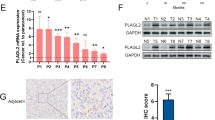Abstract
Genomic amplification at 20q11–13 is a common event in human cancers. We isolated a germline translocation breakpoint at 20q11 from a bladder cancer patient. We identified CDC91L1, the gene encoding CDC91L1 (also called phosphatidylinositol glycan class U (PIG-U), a transamidase complex unit in the glycosylphosphatidylinositol (GPI) anchoring pathway), as the only gene whose expression was affected by the translocation. CDC91L1 was amplified and overexpressed in about one-third of bladder cancer cell lines and primary tumors, as well as in oncogenic uroepithelial cells transformed with human papillomavirus (HPV) E7. Forced overexpression of CDC91L1 malignantly transformed NIH3T3 cells in vitro and in vivo. Overexpression of CDC91L1 also resulted in upregulation of the urokinase receptor (uPAR), a GPI-anchored protein, and in turn increased STAT-3 phosphorylation in bladder cancer cells. Our findings suggest that CDC91L1 is an oncogene in bladder cancer, and implicate the GPI anchoring system as a potential oncogenic pathway and therapeutic target in human cancers.
This is a preview of subscription content, access via your institution
Access options
Subscribe to this journal
Receive 12 print issues and online access
$209.00 per year
only $17.42 per issue
Buy this article
- Purchase on Springer Link
- Instant access to full article PDF
Prices may be subject to local taxes which are calculated during checkout





Similar content being viewed by others

References
Bishop, J.M. Molecular themes in oncogenesis. Cell 64, 235–248 (1991).
Weinberg, R.A. The molecular basis of oncogenes and tumor suppressor genes. Ann. NY Acad. Sci. 758, 331–338 (1995).
Weinberg, R.A. Oncogenes and tumor suppressor genes. CA Cancer J. Clin. 44, 160–170 (1994).
Dalla-Favera, R., Martinotti, S., Gallo, R.C., Erikson, J. & Croce, C.M. Translocation and rearrangements of the c-myc oncogene locus in human undifferentiated B-cell lymphomas. Science 219, 963–967 (1983).
Dalla-Favera, R. et al. Human c-myc onc gene is located on the region of chromosome 8 that is translocated in Burkitt lymphoma cells. Proc. Natl. Acad. Sci. USA 79, 7824–7827 (1982).
Kallioniemi, O.P. et al. Comparative genomic hybridization: a rapid new method for detecting and mapping DNA amplification in tumors. Semin. Cancer Biol. 4, 41–46 (1993).
Wu, G. et al. Structural analysis of the 17q22-23 amplicon identifies several independent targets of amplification in breast cancer cell lines and tumors. Cancer Res. 61, 4951–4955 (2001).
Wu, G.J. et al. 17q23 amplifications in breast cancer involve the PAT1, RAD51C, PS6K, and SIGma1B genes. Cancer Res. 60, 5371–5375 (2000).
Kallioniemi, A. et al. Identification of gains and losses of DNA sequences in primary bladder cancer by comparative genomic hybridization. Genes Chromosomes Cancer 12, 213–219 (1995).
Kallioniemi, A. et al. Detection and mapping of amplified DNA sequences in breast cancer by comparative genomic hybridization. Proc. Natl. Acad. Sci. USA 91, 2156–2160 (1994).
Muleris, M., Almeida, A., Gerbault-Seureau, M., Malfoy, B. & Dutrillaux, B. Detection of DNA amplification in 17 primary breast carcinomas with homogeneously staining regions by a modified comparative genomic hybridization technique. Genes Chromosomes Cancer 10, 160–170 (1994).
Forozan, F. et al. Comparative genomic hybridization analysis of 38 breast cancer cell lines: a basis for interpreting complementary DNA microarray data. Cancer Res. 60, 4519–4525 (2000).
Guan, X.Y. et al. Hybrid selection of transcribed sequences from microdissected DNA: isolation of genes within amplified region at 20q11-q13.2 in breast cancer. Cancer Res. 56, 3446–3450 (1996).
Savelieva, E. et al. 20q gain associates with immortalization: 20q13.2 amplification correlates with genome instability in human papillomavirus 16 E7 transformed human uroepithelial cells. Oncogene 14, 551–560 (1997).
Wimmer, K. et al. Co-amplification of a novel gene, NAG, with the N-myc gene in neuroblastoma. Oncogene 18, 233–238 (1999).
Pollack, J.R. et al. Microarray analysis reveals a major direct role of DNA copy number alteration in the transcriptional program of human breast tumors. Proc. Natl. Acad. Sci. USA 99, 12963–12968 (2002).
Anzick, S.L. et al. AIB1, a steroid receptor coactivator amplified in breast and ovarian cancer. Science 277, 965–968 (1997).
Mu, D. et al. Genomic amplification and oncogenic properties of the KCNK9 potassium channel gene. Cancer Cell 3, 297–302 (2003).
Maguire, R.T., Robins, T.S., Thorgeirsson, S.S. & Heilman, C.A. Expression of cellular myc and mos genes in undifferentiated B cell lymphomas of Burkitt and non-Burkitt types. Proc. Natl. Acad. Sci. USA 80, 1947–1950 (1983).
Grieco, M. et al. PTC is a novel rearranged form of the ret proto-oncogene and is frequently detected in vivo in human thyroid papillary carcinomas. Cell 60, 557–563 (1990).
Schoenberg, M., Kiemeney, L., Walsh, P.C., Griffin, C.A. & Sidransky, D. Germline translocation t(5;20)(p15;q11) and familial transitional cell carcinoma. J. Urol. 155, 1035–1036 (1996).
Hong, Y. et al. Human PIG-U and yeast Cdc91p are the fifth subunit of GPI transamidase that attaches GPI-anchors to proteins. Mol. Biol. Cell 14, 1780–1789 (2003).
Okamura, S. et al. p53DINP1, a p53-inducible gene, regulates p53-dependent apoptosis. Mol. Cell 8, 85–94 (2001).
Memarzadeh, S. et al. Urokinase plasminogen activator receptor: prognostic biomarker for endometrial cancer. Proc. Natl. Acad. Sci. USA 99, 10647–10652 (2002).
Dumler, I. et al. The Jak/Stat pathway and urokinase receptor signaling in human aortic vascular smooth muscle cells. J. Biol. Chem. 273, 315–321 (1998).
Yeager, T.R. et al. Overcoming cellular senescence in human cancer pathogenesis. Genes Dev. 12, 163–174 (1998).
Tanner, M.M. et al. Increased copy number at 20q13 in breast cancer: defining the critical region and exclusion of candidate genes. Cancer Res. 54, 4257–4260 (1994).
Fukushige, S. et al. Frequent gain of copy number on the long arm of chromosome 20 in human pancreatic adenocarcinoma. Genes Chromosomes Cancer 19, 161–169 (1997).
Tanner, M.M. et al. Independent amplification and frequent co-amplification of three nonsyntenic regions on the long arm of chromosome 20 in human breast cancer. Cancer Res. 56, 3441–3445 (1996).
Fitzgerald, J.M. et al. Identification of H-ras mutations in urine sediments complements cytology in the detection of bladder tumors. J. Natl. Cancer Inst. 87, 129–133 (1995).
Hovey, R.M. et al. Genetic alterations in primary bladder cancers and their metastases. Cancer Res. 58, 3555–3560 (1998).
Bringuier, P.P., Tamimi, Y., Schuuring, E. & Schalken, J. Expression of cyclin D1 and EMS1 in bladder tumours; relationship with chromosome 11q13 amplification. Oncogene 12, 1747–1753 (1996).
Friedmann, E., Salzberg, Y., Weinberger, A., Shaltiel, S. & Gerst, J.E. YOS9, the putative yeast homolog of a gene amplified in osteosarcomas, is involved in the endoplasmic reticulum (ER)-Golgi transport of GPI-anchored proteins. J. Biol. Chem. 277, 35274–35281 (2002).
Blasi, F. & Carmeliet, P. uPAR: a versatile signalling orchestrator. Nat. Rev. Mol. Cell. Biol. 3 932–943 (2002).
Acknowledgements
We thank F. Wu, N. Vij, K. Irani and A. Haile for technical support and Ras-transformed NIH3T3 cells. This work was supported by grant 5P01CA77664 from the National Cancer Institute, and by a grant from the Flight Attendant Medical Research Institute.
Author information
Authors and Affiliations
Corresponding authors
Ethics declarations
Competing interests
The authors declare no competing financial interests.
Supplementary information
Rights and permissions
About this article
Cite this article
Guo, Z., Linn, J., Wu, G. et al. CDC91L1 (PIG-U) is a newly discovered oncogene in human bladder cancer. Nat Med 10, 374–381 (2004). https://doi.org/10.1038/nm1010
Received:
Accepted:
Published:
Issue Date:
DOI: https://doi.org/10.1038/nm1010
This article is cited by
-
PIGT promotes cell growth, glycolysis, and metastasis in bladder cancer by modulating GLUT1 glycosylation and membrane trafficking
Journal of Translational Medicine (2024)
-
Structures of liganded glycosylphosphatidylinositol transamidase illuminate GPI-AP biogenesis
Nature Communications (2023)
-
The novel immune-related genes predict the prognosis of patients with hepatocellular carcinoma
Scientific Reports (2021)
-
Novel significant stage-specific differentially expressed genes in hepatocellular carcinoma
BMC Cancer (2019)
-
Angiogenesis and evading immune destruction are the main related transcriptomic characteristics to the invasive process of oral tongue cancer
Scientific Reports (2018)


